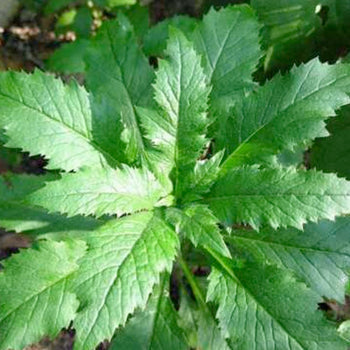
Season: Spring - Fall
Looking for a Specific Herb?
Search Our Herb Almanac Below:
|
|
|
Chenopodium ambrosioides is an annual or short-lived perennial plant (herb), growing to 1.2 m (3 ft 11 in) tall, irregularly branched, with oblong-lanceolate leaves up to 12 cm (4+1⁄2 in) long. The flowers are small and green, produced in a branched panicle at the apex of the stem.
As well as in its native areas, it is grown in warm temperate to subtropical areas of Europe and the United States (Missouri, New England, Eastern United States), sometimes becoming an invasive weed.
|
 |

Mature Height
48 Inches |
 |

Mature Width
36 Inches |
 |

Light
Sun |
 |

Water
Low |
 |
|
Uses
Ideally collected before going to seed, ambrosioides is used as a leaf vegetable, herb, and herbal tea for its pungent flavor. Raw, it has a resinous, medicinal pungency, similar to oregano, anise, fennel, or even tarragon, but stronger. The fragrance of ambrosioides is strong and unique. A common analogy is to turpentine or creosote. It has also been compared to citrus, savory, and mint.
Although it is traditionally used with black beans for flavor and its antiflatulent properties, it is also sometimes used to flavor other traditional Mexican dishes: it can be used to season quesadillas and sopes (especially those containing huitlacoche), soups, mole de olla, tamales with cheese and chili peppers, chilaquiles, eggs and potatoes, and enchiladas. It is often used as an herb in fried white rice, and it is an important ingredient for making the green salsa for chilaquiles.
|
 |
|
RECIPES
Salsa de Epazote
Ingredients
* 1 pound tomatillos, husked and sliced in half
* 1/2 white onion, cut in thick slices
* 3 garlic cloves, unpeeled
* 2 green onions, chopped
* 1 teaspoon ground cumin
* 2 serrano chiles, roasted, peeled and deseeded
* 1/2 cup chopped cilantro
* 1/4 cup chopped fresh epazote
* Salt
Instructions
Turn your broiler on high. Arrange the tomatillos, onion and garlic on a baking sheet and set under the broiler until about halfway charred. Keep an eye on it, as this can take anywhere from 5 minutes for dryish tomatillos to 15 for wet ones.
Meanwhile, char the serranos over a gas burner, holding them with tongs. This is a better method for charring your serranos because they don't cook fully this way, but if this bothers you, put the serranos under the broiler with everything else.
Remove the garlic and peel it when it's cool enough to touch. Remove the skins and seeds from the serranos. Move everything into a blender, along with all the other ingredients. Puree.
Add salt to taste.
|
|




















